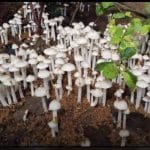Lentinus squarrosulus, also called shaggy stalked lentinus, tropical oyster mushroom, Amandegere in Kisii language-Kenya, is a species of wood-decay fungus belonging to the Polyporaceae family, widely recognised for its distinctive morphological traits and significant ecological roles. Found predominantly in tropical and subtropical regions, this fungus participates actively in nutrient cycling and ecosystem functioning. Understanding its characteristics and ecological importance provides insight into fungal biodiversity and forest health.
Morphological Features of Lentinus Squarrosulus Explained
Lentinus squarrosulus exhibits unique morphological features that aid in its identification and classification. The fruiting body typically presents a cap (pileus) that is convex to flat, often bearing dense, coarse scales or squamules—hence the species name ‘squarrosulus,’ meaning scaly or rough. The coloration of the cap ranges from pale yellow to brownish tones, with a somewhat tough and leathery texture that persists even when dried. The cap margin is characteristically curled or inrolled when young and may become wavy with age.
The gills (lamellae) of L. squarrosulus are a notable distinguishing feature; they are thick, widely spaced, and have a decurrent attachment to the stalk (stipe). The gills’ coloration varies from white to cream, gradually darkening as the spores mature. The stipe itself is central or slightly off-centre, fibrous, and shares a similar colouration to the cap but is often darker at the base. The flesh is tough and fibrous, contributing to the fungus’s durability in its natural environment.
Microscopically, Lentinus squarrosulus produces white, elliptical spores that are smooth and inamyloid, lacking any reaction to iodine-based reagents. The hyphal system is dimitic, involving generative and skeletal hyphae, which gives the fruiting body its robust and rigid structure. These morphological traits, both macroscopic and microscopic, aid in differentiating L. squarrosulus from other similar polypores and lentinoid fungi.
Ecological Role and Environmental Impact of Lentinus Squarrosulus
Lentinus squarrosulus plays a critical ecological role as a saprotrophic fungus, primarily decomposing dead hardwood and contributing to nutrient recycling within forest ecosystems. By breaking down lignin and cellulose in wood, it facilitates the decomposition process, releasing essential nutrients back into the soil, thereby supporting plant growth and maintaining soil fertility. This decomposition activity helps sustain the balance of carbon cycling in forest habitats.
Beyond nutrient cycling, L. squarrosulus contributes to the structural complexity of forest ecosystems. The decayed wood it colonises becomes a habitat for various invertebrates and microorganisms, enhancing biodiversity. In certain tropical forests, this fungus participates in symbiotic or competitive interactions with other fungi and microbes, influencing microbial community dynamics and succession patterns on decaying wood substrates.
Additionally, Lentinus squarrosulus has potential environmental applications due to its ligninolytic enzyme system. These enzymes are capable of degrading complex organic pollutants, making the fungus a candidate for bioremediation processes aimed at mitigating environmental contaminants. Its ecological versatility underscores its importance not only in natural ecosystems but also in applied environmental science.
Lentinus squarrosulus is a fungus of notable morphological distinctiveness and ecological significance. Its role in wood decomposition and nutrient cycling positions it as a key player in maintaining forest ecosystem health and biodiversity. Moreover, its potential utility in bioremediation highlights the broader environmental applications of this species, meriting further research and conservation consideration.
Cooking Lentinus Squarrosulus (Shaggy Stalked Lentinus)
Lentinus squarrosulus is an edible wild mushroom commonly found in tropical regions. Here’s how to cook it:
Basic Preparation
- Clean the mushrooms by gently brushing off any dirt or debris. Avoid soaking them as they absorb water easily.
- Trim off the tough base of the stems if present.
- Tear or cut larger mushrooms into smaller, bite-sized pieces.
Simple Sauté Method
- Heat 2 tablespoons of oil or butter in a pan over medium-high heat.
- Add 1-2 minced garlic cloves and sauté for 30 seconds.
- Add the mushrooms and cook for 5-7 minutes until they release their moisture and begin to brown.
- Season with salt, pepper, and fresh herbs like thyme or parsley.
- Finish with a squeeze of lemon juice for brightness.
Other Cooking Methods
- Stir-fry: Add to vegetable stir-fries with soy sauce and ginger.
- Soup: Include in clear broths or creamy mushroom soups.
- Grilling: Brush with oil and grill for 3-4 minutes per side.
- Curry: Add to coconut-based curries with local spices.
Flavor Pairings
These mushrooms have a mild, slightly nutty flavour that pairs well with:
- Garlic and herbs
- Soy sauce or fish sauce
- Chili peppers
- Coconut milk
- Rice or noodles
Nutritional Profile of Lentinus Squarrosulus
Lentinus squarrosulus mushrooms offer excellent nutritional value, particularly as a plant-based food. Here’s a breakdown of their nutritional benefits:
Key Nutrients
- Protein: Contains all essential amino acids, making it a good protein source (approximately 20-25% protein by dry weight)
- Dietary Fibre: Rich in both soluble and insoluble fibre
- Vitamins: Contains B vitamins, including:
- B2 (riboflavin)
- B3 (niacin)
- B5 (pantothenic acid)
- Folate
- Minerals:
- Potassium
- Phosphorus
- Magnesium
- Zinc
- Selenium (an important antioxidant)
- Iron
Health Benefits
- Low in calories: Approximately 30-35 calories per 100g fresh weight
- Very low fat content: Less than 1g per 100g
- No cholesterol
- Low sodium
- Low carbohydrate content
Bioactive Compounds
Lentinus squarrosulus contains several bioactive compounds with potential health benefits:
- Beta-glucans: May help support immune function
- Polysaccharides: Some studies suggest anti-inflammatory properties
- Antioxidants: Help neutralize free radicals in the body
These mushrooms are particularly valuable for vegetarian and vegan diets as they provide nutrients often found in animal products, especially B vitamins and protein with a complete amino acid profile.
Related Posts
- Lentinus Squarrosulus Characteristics and Ecological Importance
- The Downsides of Convenience Foods: What You Need to Know
- The Disadvantages of Using Leftover Foods
- Why You Should Keep Peeled Potatoes in Cold Water
- Key Qualities of an Effective Kitchen Plan for Optimal Cooking
- The Advantages of Baking: Why You Should Embrace This Cooking Method
- Factors Influencing Cooking Methods: A Comprehensive Guide
- How to Finish a White Cotton Tablecloth: A Step-by-Step Guide
- Disadvantages of Using Charcoal for Cooking: Important Considerations
- Understanding Food Contamination Risks from Cooks
- The Importance of Covering Saucepans While Cooking


